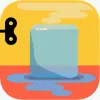Take a look inside 10 images
States of Matter by Tinybop
Pros: Free-form play, helpful object labels, useful handbook with play ideas.
Cons: Lack of help inside the app, only a handful of materials for each state of matter, no way to mix substances.
Bottom Line: A flexible, sandbox-y chemistry app built for exploration that will help early elementary students play with chemistry concepts safely.
The States of Matter by Tinybop Handbook is the place to start to orient yourself and your students to the app. It includes plenty of ideas for how to interact with the app, scientific facts, discussion questions, and vocabulary that doesn't talk down to students, both within the text and in a glossary. It breaks up the app into solids, liquids, and gases, and also explains why plasma isn't included in the app. Ideally, teachers would have their own device to follow along with the handbook alongside students using the app, but it can also be printed out from the website. For those in multilingual schools, the text labels can be set to any of over 40 languages.
One fun way to use the app would be to challenge students to guess what will happen as the temperature increases or decreases with each substance. What happens to honey when it gets cold? What happens to plastic toys if they get too hot? Challenge your students to ask questions and devise hypotheses, and then test them out in the app. Ask your students what types of phase changes they experience in their daily lives in contexts such as the weather and cooking and with objects like an ice cream cone on a hot day.
States of Matter is Tinybop's 11th title in their Explorer's Library series of apps. In it, students can play around and experiment with the concepts of states of matter (solid, liquid, gas) and phase changes. Students choose a vessel to use -- some have lids, pouring spouts, drain holes -- and then fill it with a particular solid, liquid, or gas by tapping the correct chute. Students can then move the substance around by tapping or tilting their device, change its temperature up or down, see how its molecules are arranged and moving, and observe color, shape, and behavior. Turn up the volume, and some substances make different sounds in different circumstances. If teachers allow the app to use the microphone when interacting with helium, students can hear a simulation of what they might sound like if they inhaled any. Substances available for play include ice cubes, plastic toys, popcorn, gold objects, soda, honey, helium, bromine, oxygen, chlorine, and more. Kids can study only one substance at a time, which keeps it simple for young students but limits experimentation options. Students can change the current substance by changing the chute or the vessel in use.
The thermometer on the side shows the melting/freezing point and boiling point, where applicable, and other important temperatures such as glass transition temperature for some objects and popping point for the popcorn. Students can increase and decrease the temperature at will and see which phase changes can be re-created and which ones are irreversible (burning popcorn is more a chemical reaction than a phase change, but the app doesn't get into this more complicated chemistry). There's a slider that students can move back and forth to see how the molecules are arranged and how they behave in the solids, liquids, and gases.
The States of Matter by Tinybop Handbook, which can guide parents and teachers in how to use this app with students, is available on the app's main screen or on the Tinybop website.
With States of Matter by Tinybop, students can see what happens in temperature and phase changes with several different substances, helping them experiment in a way that would be difficult in a classroom or home. Open-ended play encourages exploration and experimentation, allowing students to follow their curiosity and try out unconventional things. They'll learn which materials and states of matter take the shape of their container, the melting and freezing points of different substances, and how the attributes of substances change as the temperature goes up or down. There are even semi-accurate sound effects that go along with the action. The thermometer can be changed from Fahrenheit to Celsius and even to Kelvin, so students can also learn about the different temperature scales and how they compare.
Students don't seem to be able to choose which substance they're using, but there are only a few of each type (solid/liquid/gas), so they can rotate through them fairly easily. However, this limited selection can get tired quickly, and it'll be harder for students to go straight to a specific substance since they just get what they get.



















